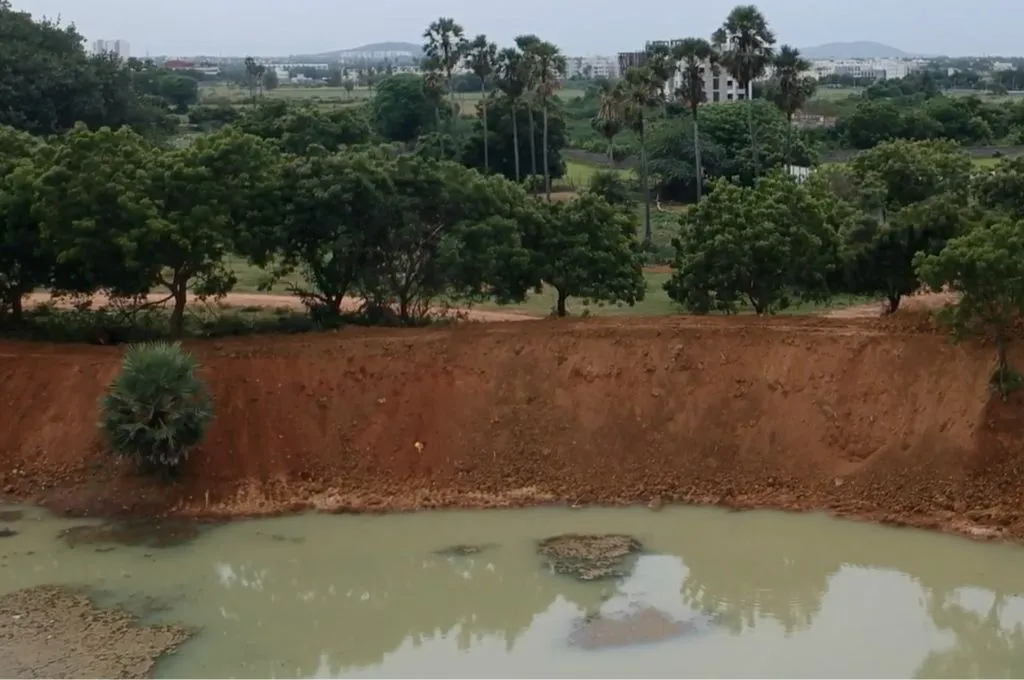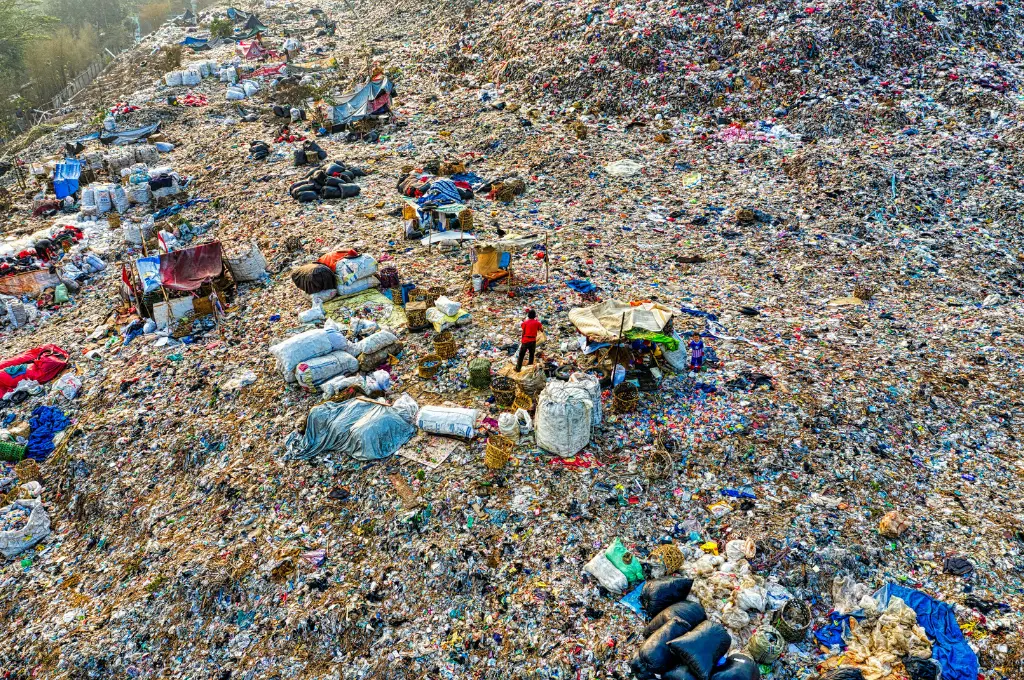India’s urban areas are running out of water in more ways than one. According to India’s first National Water Bodies Census 2023, only 3 percent of the country’s 2.4 million water bodies lie in urban areas. As urbanisation accelerates—with urban population projected to double from 410 million in 2014 to 814 million by 2050—infrastructure increasingly threatens to consume the country’s blue spaces, including lakes, ponds, marshlands, and swamps. A 10-city study conducted by World Resources Institute (WRI) India found that between 2000 and 2015, while the built-up area in the surveyed cities increased, their blue cover decreased by an average of 15 percent.
The loss of water bodies in urban areas is hard to reverse. As they disappear, so do the ecosystem services they provide, such as water supply, groundwater recharge, stormwater and microclimate management, and recreation. However, water bodies that are on the brink of vanishing but have not yet reached the point of no return can still be salvaged. Timely, scientific action backed by community-focused conservation plans can not only restore urban blue cover but also secure its long-term health, with trickle-down benefits to localities at large.
At Environmentalist Foundation of India (EFI), we have been working on the scientific revival of freshwater bodies through community-based, collaborative conservation efforts across the country. Depending on the size and complexities of a water body, its restoration—from planning to execution—can take anywhere between three months and three years.

One of our main focus geographies is Chennai, the largest city in Tamil Nadu, which was once home to more than 474 wetland complexes that served as a lifeline for its people, nature, and wildlife. Wetlands are land areas capable of holding surface water and supporting aquatic flora and fauna. In urban settings, wetlands take various forms, such as ponds and lakes. In a city like Chennai, where floods and coastal erosion are common occurrences, wetlands play a critical role in climate adaptation. They are especially valuable during extreme weather events, as they help absorb excess rainwater. Additionally, wetlands aid in recharging groundwater and serve as a vital source of water during dry periods. Over the last three decades, however, more than 85 percent of these water bodies in the city have been degraded due to illegal encroachments, untreated sewage inlets, garbage dumping, land reclamation, and infrastructure and development projects.
In 2020, we undertook the restoration of one such crucial wetland—Polachery lake in Tamil Nadu’s Chengalpattu district. When we began our work four years ago, the 13-acre lake, located approximately 35 km south of Chennai, had lost nearly all semblance of a water body due to a lack of management.
Understanding the ecosystem
One of our key learnings over the years is that there is no one-size-fits-all solution for water bodies. Each one requires careful study and a solution that is unique to its specific issues as well as to the cultural and social context of the community living around it. Therefore, across all our restoration projects, we undertake a one-month-long evaluation during which we study various aspects of the water body, such as water flow patterns, hydrological conditions, and soil quality. Geospatial and climate analyses are also conducted to understand peak periods, when the water body is full, and seasonal variations.
To discern the extent of degradation of the Polachery lake, we undertook an in-depth study of the lake and its surrounding area. Collaborating with scientist volunteers within our team and network, we analysed satellite imagery of the lake across different timelines, conducted water and soil tests to understand the impact of localised pollution, identified the region’s hydrology to understand water flow dynamics, and engaged in a dialogue with the local community to understand their relationship with the water body.
Our findings indicated that the lake was in a state of decline with excess silt, broken bunds, and the proliferation of weeds, along with localised garbage dumping. Since the lake does not have proper undulation or contour, water permeation and storage were majorly hindered. The lake remained bone dry for most of the year—a condition aided by its rocky bed, which stored little water, and worsened by invasive plants that drained what little water was left. The lack of healthy vegetation in and around the lake robbed it of the biodiversity it could have supported.

This month-long evaluation helped us design a customised restoration plan.
Implementing the plan
Based on our findings, we undertook several steps to nurse the wetland back to health:
1. Removed invasive species: A variety of invasive weeds, such as Prosopis juliflora and bulrush, surrounded Polachery lake. Fauna couldn’t thrive among these plants as they don’t bear fruits and are ill-suited to shelter birds and amphibians. So, our first step was to weed the entire area. We managed to remove 14 tons of invasive species with the help of machinery to restore the lake to its natural state. At the same time, we removed piles of solid waste that had been dumped along the lake’s boundary by locals.

2. Desilting for rebuilding: Previously, during the monsoon, Polachery lake would routinely overflow and flood the local community because of its worn-down bunds. Years of neglect had led to a large amount of silt accumulating on the lake bed, creating heaps and mounds that gave it an uneven contour. This reduced the lake’s water storage capacity. We used machinery to desilt and level the lake bed. Government laws prohibit the transfer of silt from its source. In fact, we are advised by the respective government officials not to remove silt from the water body.

So, we used the excess silt to repair the bunds and build dual embankments around the lake. Dual embankments are two-step structures consisting of a primary and a secondary bund, designed to provide double protection for the lake. If one bund were to crumble under pressure, the second would still contain the water, thus improving the water body’s flood resilience and preventing soil erosion. To direct the flow of water and reduce the pressure on the embankments, we also created nesting islands using the silt. We planted native trees such as neem and bamboo, making these islands a haven for local fauna to nest, forage, and hunt.

3. Digging recharge puddles: Another crucial component of our plan was the creation of recharge puddles, also known as ‘baby ponds’. These are the deepest points within the water body and play a vital role in increasing the groundwater recharge rate. Even during the hottest summers, these recharge puddles retain water, ensuring a continuous supply to support the local flora and fauna.

4. Fencing the lake: To safeguard the water body and prevent future encroachment, we installed protective metal fencing around the lake. This barrier limits human interaction, reducing the likelihood of disturbances to the delicate ecosystem. However, to allow responsible use of the water body, we created controlled access points after consulting with the local community.

5. Targeted monitoring of nearby water bodies: We don’t limit our restoration efforts to a single site; instead, we identify other water bodies within a five-kilometre radius that also need attention. For example, while restoring Polachery lake, we identified five water bodies in the region, including the Thazhambur Gandhi pond, Polachery Gangaiamman pond, Mambakkam Periya Kuttai, and Ottiyambakkam lake. The proximity enables regular checks, helping us ensure that the water bodies remain in good condition even after the project has ended.
This model of consistent monitoring has been applied to all 468 water bodies we’ve restored. Our team conducts monthly lake audits to identify issues such as broken fences, fallen trees, or other maintenance needs at each site.
Building partnerships for long-term sustainability
Conservation and restoration efforts cannot succeed in isolation. To ensure lasting impact, collaborating with the right partners facilitates the sharing of resources, expertise, and responsibilities, helping to establish a sustainable framework for managing and protecting the restored ecosystems. For us, this means partnerships at three key levels.
1. The government
A critical component of our plans is always working closely with local government bodies—such as municipal corporations, district collectorates, water resource departments, and irrigation departments—depending on the project location. For the Polachery lake restoration, we partnered with the Chengalpattu collectorate. This collaboration involved regular report submissions and joint site visits. We kept the district administration informed at every step of the process, as their administrative support is crucial for demarcating boundaries and addressing encroachments, ensuring both the legal and structural integrity of the site. In Chengalpattu, we have successfully restored approximately 65 water bodies, largely due to the strong rapport we have built with the local government.
2. The community
Organisations cannot work on a water body without engaging with the local community and seeking their views on it. Not adopting such an approach could result in hostility and resistance.
Community involvement is therefore at the heart of our restoration efforts. We make it a priority to understand the community’s relationship with the water body and involve them in every stage of the restoration process. For instance, at Polachery lake, we organised lake clean-ups, nature walks, birdwatching events, and plantation drives to foster community awareness and instil a sense of ownership and connection to the lake. These engagements resulted in the establishment of a ‘lake watch committee’ within the community, empowering residents to address issues such as fence damage or waste dumping. Whenever possible, we also tried to employ locals in the lake restoration work.
Our outreach extended to local institutions such as schools and colleges too, involving students in educational activities to raise awareness about the local biodiversity.
When a water body is restored and a sense of ownership is cultivated within the local community, it can inspire the same pride and care that cities reserve for their iconic lakes and ponds. This renewed connection not only protects the water body but also strengthens urban climate resilience.
3. The funders
Our primary funding for restoration projects comes from our CSR partners. However, obtaining CSR funds can be challenging. Often, CSR funding is inclined towards causes that offer more immediate and visible impacts, whereas ecological restoration is a long-term commitment. Moreover, it can be difficult to convince companies that ecological restoration is not the same thing as a beautification project. Funders sometimes request additions such as walking tracks or boating facilities, but our focus is on reducing human intervention at the water body. The challenge, therefore, is helping corporate partners understand what ecological restoration truly involves and why it is essential for both people and the environment. This process is much smoother when we align with partners who share our values. For example, if their goal is to fund efforts that positively impact the community, we highlight our past restoration projects and their proven success—because they directly support that aim.
Often, water bodies that aren’t popular tourist destinations fail to attract attention or action when they fall into neglect. However, as the climate crisis worsens, investing in the restoration and conservation of these often-overlooked water resources ensures they continue to provide essential ecological services, mitigate the impacts of climate change, and support the well-being of urban populations for years to come.
—
Know more
- Learn more about the restoration of the Polachery lake.
- Learn how decades of industrial pollution have pushed the Ennore wetland into an environmental crisis.
- Learn why conserving wetlands is critical for urban climate resilience.




